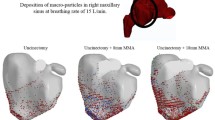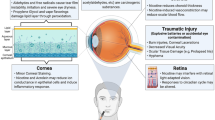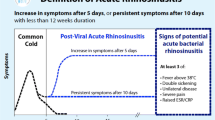Abstract
Background
Dexpanthenol-containing ointments/fluids are recommended to restore impaired nasal mucosa. To date, there are no data about the influence of dexpanthenol or formulations including dexpanthenol on ciliary beat frequency (CBF) of nasal epithelial cells.
Methods
We tested the ciliary beat frequency of human nasal epithelial cells in RPMI 1640 cell solution using in vitro high-frequency video microscopy every 60 s over a period of 15 min (min). Bepanthen® solution and dexpanthenol in two clinically relevant concentrations (1.67% and 3.33%) were added to the cells. Addition of sterile water served as control group. To get a better overview, the measurements after 1 min, 5 min and 15 min were combined.
Results
The CBF in the control group (n = 17) after 15 min was 7.3 ± 2.6 Hz. In comparison, the CBF after 15 min was 1.8 ± 1.0 Hz in the 3.33% Bepanthen® group (n = 17) and 3.2 ± 1.2 Hz in the 1.67% group, which was statistically significantly lower in both groups (p < 0.001). With regard to the dexpanthenol group (n = 17) a CBF of 6.0 ± 2.6 Hz with 3.33% and 6.1 ± 2.4 Hz with 1.67% dexpanthenol, was detected, which was again statistically significantly lower (p = 0.06) compared to the control group except CBF at 15 min with 1.57% (n = 17; p = 0.04). In general, the effect on CBF was less pronounced with dexpanthenol compared with Bepanthen® with a statistically significant difference between the two formulations. The results were verified by calculating an analysis of variance (ANOVA).
Conclusions
Bepanthen® as an ointment, solution or inhalation is commonly used in ENT for mucosal care. Our results have shown that both substances reduce CBF in clinically relevant concentrations, although the effect was more pronounced with Bepanthen® compared to dexpanthenol solution, which could be related to additives or change of physical properties in the solution. Further research is needed to assess potential clinical relevance.


Similar content being viewed by others
Data availability
The datasets used and/or analysed during the current study are available from the corresponding author on request.
References
Mosges R, Shah-Hosseini K, Hucke HP, Joisten MJ (2017) Dexpanthenol: an overview of its contribution to symptom relief in acute rhinitis treated with decongestant nasal sprays. Adv Ther 34(8):1850–1858
Klocker N, Verse T, Rudolph P (2003) The protective effect of dexpanthenol in nasal sprays. First results of cytotoxic and ciliary-toxic studies in vitro. Laryngorhinootologie 82(3):177–182
Proksch E, de Bony R, Trapp S, Boudon S (2017) Topical use of dexpanthenol: a 70th anniversary article. J Dermatolog Treat 28(8):766–773
Hosemann W, Wigand ME, Gode U, Langer F, Dunker I (1991) Normal wound healing of the paranasal sinuses: clinical and experimental investigations. Eur Arch Otorhinolaryngol 248(7):390–394
Biro K, Thaci D, Ochsendorf FR, Kaufmann R, Boehncke WH (2003) Efficacy of dexpanthenol in skin protection against irritation: a double-blind, placebo-controlled study. Contact Dermatitis 49(2):80–84
Stüttgen G, Krause H (1960) Die percutane Absorption von tritium-markiertem Panthenol bei Mensch und Tier. Arch Klin Exp Dermatol 209(6):578–582
Gimenez-Arnau A (2016) Standards for the protection of skin barrier function. Curr Probl Dermatol 49:123–134
Slyshenkov VS, Omelyanchik SN, Moiseenok AG, Trebukhina RV, Wojtczak L (1998) Pantothenol protects rats against some deleterious effects of gamma radiation. Free Radic Biol Med 24(6):894–899
Slyshenkov VS, Omelyanchik SN, Moiseenok AG, Petushok NE, Wojtczak L (1999) Protection by pantothenol and beta-carotene against liver damage produced by low-dose gamma radiation. Acta Biochim Pol 46(2):239–248
Sedaghat MH, Shahmardan MM, Norouzi M, Heydari M (2016) Effect of cilia beat frequency on muco-ciliary clearance. J Biomed Phys Eng 6(4):265–278
Braiman A, Priel Z (2008) Efficient mucociliary transport relies on efficient regulation of ciliary beating. Respir Physiol Neurobiol 163(1–3):202–207
Bustamante-Marin XM, Ostrowski LE (2017) Cilia and mucociliary clearance. Cold Spring Harb Perspect Biol 9(4):a028241
Comba A, Atan D (2020) Evaluation of nasal mucociliary clearance time in children with celiac disease. Int J Pediatr Otorhinolaryngol 133:109936
Mirra V, Werner C, Santamaria F (2017) Primary ciliary dyskinesia: an update on clinical aspects, genetics, diagnosis, and future treatment strategies. Front Pediatr 5:135
Boek WM, Graamans K, Natzijl H, van Rijk PP, Huizing EH (2002) Nasal mucociliary transport: new evidence for a key role of ciliary beat frequency. Laryngoscope 112(3):570–573
Cohen NA (2006) Sinonasal mucociliary clearance in health and disease. Ann Otol Rhinol Laryngol Suppl 196:20–26
Birk R, Aderhold C, Stern-Strater J, Hormann K, Stuck BA, Sommer JU (2015) Polyhexanide-containing solution reduces ciliary beat frequency of human nasal epithelial cells in vitro. Eur Arch Otorhinolaryngol 272(2):377–383
Birk R, Aderhold C, Wenzel A et al (2016) Mupirocin reduces ciliary beat frequency of human nasal epithelial cells. Eur Arch Otorhinolaryngol 273(12):4335–4341
Behr W, Horschke F, Nastev A et al (2021) Effects of tranexamic acid on human nasal ciliary beat frequency. Eur Arch Otorhinolaryngol 278:3351–3356
Sommer JU, Gross S, Hormann K, Stuck BA (2010) Time-dependent changes in nasal ciliary beat frequency. Eur Arch Otorhinolaryngol 267(9):1383–1387
Jorissen M, Bessems A (1995) Influence of culture duration and ciliogenesis on the relationship between ciliary beat frequency and temperature in nasal epithelial cells. Eur Arch Otorhinolaryngol 252(8):451–454
Sauvalle M, Alvo A (2018) Effect of the temperature of nasal lavages on mucociliary clearance: a randomised controlled trial. Eur Arch Otorhinolaryngol 275(9):2403–2406
Sisson JH, Stoner JA, Ammons BA, Wyatt TA (2003) All-digital image capture and whole-field analysis of ciliary beat frequency. J Microsc 211(Pt 2):103–111
Nastev A, Sommer JU, Behr W et al (2020) Cocaine reduces ciliary beat frequency of human nasal epithelial cells. In Vivo Nov-Dec 34(6):3285–3289
Birk R, Handel A, Wenzel A et al (2017) Heated air humidification versus cold air nebulization in newly tracheostomized patients. Head Neck 39(12):2481–2487
R: A language and environment for statistical computing [computer program]. Version. Vienna, Austria: R Foundation for statistical Computing; 2020
Hahn C, Bohm M, Allekotte S, Mosges R (2013) Tolerability and effects on quality of life of liposomal nasal spray treatment compared to nasal ointment containing dexpanthenol or isotonic NaCl spray in patients with rhinitis sicca. Eur Arch Otorhinolaryngol 270(9):2465–2472
Eloy P, Andrews P, Poirrier AL (2017) Postoperative care in endoscopic sinus surgery: a critical review. Curr Opin Otolaryngol Head Neck Surg 25(1):35–42
Rudmik L, Soler ZM, Orlandi RR et al (2011) Early postoperative care following endoscopic sinus surgery: an evidence-based review with recommendations. Int Forum Allergy Rhinol Nov-Dec 1(6):417–430
Yildirim G, Kumral TL, Altindag C, Ozdemir E, Uyar Y (2017) The effect of dexpanthenol-vitamin A (Nazalnem) on silastic splints after nasal septal surgery. J Craniofac Surg 28(8):2139–2142
Fooanant S, Chaiyasate S, Roongrotwattanasiri K (2008) Comparison on the efficacy of dexpanthenol in sea water and saline in postoperative endoscopic sinus surgery. J Med Assoc Thai 91(10):1558–1563
Tantilipikorn P, Tunsuriyawong P, Jareoncharsri P et al (2012) A randomized, prospective, double-blind study of the efficacy of dexpanthenol nasal spray on the postoperative treatment of patients with chronic rhinosinusitis after endoscopic sinus surgery. J Med Assoc Thai 95(1):58–63
Gouteva I, Shah-Hosseini K, Meiser P (2014) Clinical efficacy of a spray containing hyaluronic acid and dexpanthenol after surgery in the nasal cavity (septoplasty, simple ethmoid sinus surgery, and turbinate surgery). J Allergy (Cairo) 2014:635490
Beck R, Sorge M, Schneider A, Dietz A (2018) Current approaches to epistaxis treatment in primary and secondary care. Dtsch Arztebl Int 115(1–02):12–22
Kocak HE, Bilece ZT, Keskin M, Ulusoy HA, Koc AK, Kaya KH (2019) Comparison of topical treatment methods used in recurrent anterior epistaxis: a randomized clinical trial. Braz J Otorhinolaryngol
Ozmen S, Ozmen OA (2012) Is local ointment or cauterization more effective in childhood recurrent epistaxis. Int J Pediatr Otorhinolaryngol 76(6):783–786
Klocker N, Rudolph P, Verse T (2004) Evaluation of protective and therapeutic effects of dexpanthenol on nasal decongestants and preservatives: results of cytotoxic studies in vitro. Am J Rhinol Sep-Oct 18(5):315–320
Kehrl W, Sonnemann U, Dethlefsen U (2003) Advance in therapy of acute rhinitis–comparison of efficacy and safety of xylometazoline in combination xylometazoline-dexpanthenol in patients with acute rhinitis. Laryngorhinootologie 82(4):266–271
Kehrl W, Sonnemann U (1998) Dexpanthenol nasal spray as an effective therapeutic principle for treatment of rhinitis sicca anterior. Laryngorhinootologie 77(9):506–512
Palmberger TF, Augustijns P, Vetter A, Bernkop-Schnurch A (2011) Safety assessment of thiolated polymers: effect on ciliary beat frequency in human nasal epithelial cells. Drug Dev Ind Pharm 37(12):1455–1462
Munkholm M, Mortensen J (2014) Mucociliary clearance: pathophysiological aspects. Clin Physiol Funct Imaging 34(3):171–177
Robinson M, Bye PT (2002) Mucociliary clearance in cystic fibrosis. Pediatr Pulmonol 33(4):293–306
Author information
Authors and Affiliations
Corresponding author
Additional information
Publisher's Note
Springer Nature remains neutral with regard to jurisdictional claims in published maps and institutional affiliations.
Rights and permissions
Springer Nature or its licensor (e.g. a society or other partner) holds exclusive rights to this article under a publishing agreement with the author(s) or other rightsholder(s); author self-archiving of the accepted manuscript version of this article is solely governed by the terms of such publishing agreement and applicable law.
About this article
Cite this article
Behr, W., Li, H., Birk, R. et al. Impact of Bepanthen® and dexpanthenol on human nasal ciliary beat frequency in vitro. Eur Arch Otorhinolaryngol 280, 3731–3736 (2023). https://doi.org/10.1007/s00405-023-07916-y
Received:
Accepted:
Published:
Issue Date:
DOI: https://doi.org/10.1007/s00405-023-07916-y




